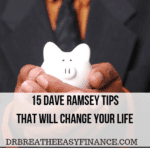If you enjoy reading and learning about personal finance, then it’s safe to say you’ve probably heard the name, Dave Ramsey.
Since the ’90s, The Dave Ramsey Baby Steps have helped millions of people get out of debt and start them down the path to achieving financial freedom. We even wrote our own 12 toddler steps to financial freedom by modifying some of Dave’s steps.
No matter how many blogs I read or podcasts I listen to, his name stands out more than any others.
Why?
It’s because he understands the motivation people need to get out of debt and has built his empire around this method.
Heck, he even inspired me to go through his Master Training Program and become a financial coach.
I think the world would be a better place if we take his example by sharing our failures with others to help them avoid the same mistakes that we make.
While in his early 20’s, Dave had owned over a million dollars worth of real estate but lost it all and went bankrupt. He then turned his failure into a multi-million dollar company that started with a radio show.

He’s also a marketing wizard. Early in his career, he wrote the book Financial Peace (then later, Financial Peace Revisited) and offered it for free to his church members.
When he later started his radio show, he was able to use it as a platform to both sell the book and the Dave Ramsey Baby Steps and the rest is history…
His entire focus then, and now, centers around his 7 Baby Steps and is known for encouraging people to become debt-free.
Whether you agree with him or not, I think most would at least benefit from listening to what he has to say.
Both my wife and I owe him a debt of gratitude (no pun intended!).
So today I’d like to give an overview of his 7 Baby Steps.
Table of Contents
Dave Ramsey Baby Steps Introduction
The Dave Ramsey Baby Steps are straight forward. They’re simple to understand, but for some, they’re difficult to accomplish.
- Step 1: $1,000 in an emergency fund.
- Step 2: Pay off all debt except the house utilizing the debt snowball.
- Step 3: Three to six months of savings in a fully-funded emergency fund.
- Step 4: Invest 15% of your household income into Roth IRAs and pre-tax retirement plans.
- Step 5: College Funding (i.e. 529 plan)
- Step 6: Pay off your home early.
- Step 7: Build wealth and give.
For those of you that like visual explanations, here’s the baby steps to to financial freedom via his website:

The Breakdown Of Each Step
Dave created a course to help people he calls Financial Peace University. You can either take it online or find a church near you that offers it.
His 7 step system is the cornerstone of his course and provides a road map to help people get out of debt and move toward financial freedom.
Here’s a step by step breakdown of each from Dave (not New Kids on The Block!).
Step 1: Save $1,000 in an Emergency Fund
Have you ever had something bad happen when you could least afford to? Maybe your A/C unit went out in the heat of the summer or you totaled your car.
There’s a saying that can explain this phenomenon called Murphy’s Law.
It states:
“Anything that can go wrong will go wrong.”
It’s for this reason that Dave recommends starting off by focusing all your attention and energy on saving up $1,000 in an account and label it for emergencies only.
This has been the cause of many debates as Dave thinks $1,000 can be enough to ward off most financial disasters, where others don’t. In my opinion, I think doctors and other high-income professionals make enough to save more than this, somewhere in the $3,000 – $5,000 range.
But I get where he’s coming from. He wants to get people to have a “small” win first, to encourage them to continue to the next baby step…
Step 2: Pay Off All Debt Except Your Mortgage
Baby Step 2 is all about psychology. Remember when I mentioned earlier that Dave is a master of getting people motivated to pay off their debt? This step is one of the most important ones that show his power of motivation by using something he calls “The Debt Snowball“.
The Debt Snowball gives people quick wins from the start, just like in Baby Step #1. It keeps people motivated because the majority of people will stay in this step for several years before they get rid of their consumer debt altogether. The quick wins help to keep folks motivated so they can continue to stay the course.
The Debt Snowball method is where you list all of your debts (except house) from smallest to largest. Next, you make minimum payments on all of the debts and put every extra dollar you can spare towards the smallest one until it’s gone.
After the smallest is paid off, you move on to the next one on your list. With that one, you simply add what you were paying on the debt before it + the minimum payment you were already paying until it’s paid off. Continue this process with all your debts on the list until you’re consumer debt-free.
We created our list on a dry erase board which helped keep us even more motivated through the process. Once we paid off a debt, we’d erase it then move on to the next one. We also listed the amount of money we were putting towards them each month which forced me to want to attempt to add more and more.
There are chemicals in the brain that actually enhance The Snowball. As you start paying off each loan one by one and the snowball starts growing, it causes the brain to release chemicals whenever you win something such as dopamine and serotonin. These chemicals cause you to want to continue the process more and more.
Once you’ve completed this step, congratulations! You’re consumer debt-free! It’s now time to move on to Baby Step #3…
Baby Step 3: Finish The Emergency Fund With 3 To 6 Months Of Savings
At this point, you’ve gotten rid of your consumer debt and should have a good chunk of cash to start dispersing elsewhere. The temptation can be to jump the gun and start retirement investing, funding kid’s college accounts or paying off the house early.
Now there’s nothing wrong with doing any of those things. And Dave wants us to do them… but after we finish building up our emergency fund with 3 to 6 months of monthly expenses.
He claims that by doing it this way, we’re reducing the risk of having to go back into debt if we experience an emergency.
If you don’t take his advice then how would you handle an emergency? Pull money from your retirement account? Tap into your kid’s college savings? Not good choices.
Once you’ve completed this step, you now have protected your family with a nice buffer against major financial emergencies.
Baby Step 4: Invest 15% Of Income Into Roth IRAs And Pre-Tax Retirement
One of the frequently asked questions I get from coaching clients when teaching them these steps is, “Why is retirement ahead of college funding for our kids?”
Great question. Let’s briefly think through this. It’s natural to want to put our kids ahead of ourselves. I get that as a father. I’d do anything for my kids if it’s for their own good (not another X-box though).
But what if you end up without sufficient retirement income because you made college funding a higher priority? You’d have to depend on your kids to take care of you. Mine can’t keep their rooms clean so I want to take care of myself!
So before you begin doing anything with the excess money left over from paying off the consumer debt, Dave suggests investing 15% in your retirement account such as a 401(k), Roth IRA, 403(b) or other.
I’ve said this before and I’ll say this again, high-income professionals should be able to invest at least 20% or more of their gross household income into retirement accounts. If you can’t, that’s not a big deal. But if you can, then that’s just less time it will take to reach financial freedom.
Baby Step 5: College Funding For Kids
By the time you reach this Step, you should:
- have an emergency fund with 3-6 months of expenses
- be debt-free (except a mortgage)
- be investing at least 15% or more of your gross income
Now that you have your finances in order, it’s time to put some money back for the kids college. Dave recommends using 529 plans and Coverdell Education Savings Accounts (ESAs). These are tax-advantaged accounts specifically used for educational expenses.
Baby Step 6: Pay Off Your Home Early
At this stage of the game, Dave recommends that you take any extra money coming in after you’ve progressed through the other Baby Steps in order, and throw it towards the mortgage.
You’ll hear arguments stating that you should pay off your house early and those that tell you investing that extra money is the way to go.
The “don’t pay off your mortgage folks” are looking at this strictly from a numbers standpoint. When we paid off our mortgage in 2017, we did so more from a psychological point of view.
For us, there was nothing like the feeling of driving up to the house each day knowing that we owned it. The grass even felt different!
Whenever our family hears talk about how the wealthy are “bad” or the evil “1%” take advantage of people, we remind them of how they got to where they are and of all the good that they do for others.
Our boys are constantly told that being successful in life is going to attract many “haters”. But also that they should remember, the MORE money they make, the MORE people they can help.
This leads us to the final Baby Step #7….
Baby Step 7: Build Wealth And Give Generously
If you’ve made it to Baby Step #7, congratulations! You don’t owe anybody anything and now it’s time to really build wealth and help others. For those of us that make it to this Step, this is what Dave calls your time to “Live and give like no one else.”
It’s also the ending in his book, The Total Money Makeover. It’s what he wants all of his readers to obtain, financial independence, to do whatever we want to do both for ourselves and others.
2 Corinthians 9:11 “You will be enriched in every way so that you can be generous on every occasion, and through us your generosity will result in thanksgiving to God.”
Building Wealth
With no consumer debt, 3-6 months of expenses saved, 15%+ of your income going into retirement accounts, college accounts being funded and the mortgage paid off, you should have extra money to use to begin building massive amounts of wealth.
To be quite honest, I haven’t given the “building wealth” instruction he gives much thought. But the more I think about it, the more I realize that the sky’s the limit whenever you reach this point in your life.
He mentions investing in both mutual funds and real estate. Don’t forget about setting up and funding a Health Savings Account (HSA) and using its triple tax advantage. I recommend that you pay your medical expenses out of pocket and let the HSA continue to grow to use it as another form of retirement account.
After maxing out our retirement accounts, we funnel extra money both to index funds and real estate via apartment syndications.
Real estate crowd funding is also another option. Something else to consider is creating multiple sources of passive income via side hustles.
One of the reasons I started this blog was to keep others from making the same financial mistakes I’d made in the past. This is a perfect example of starting a side gig that you have some type of interest in.
Giving
Dennis Swanberg, motivational speaker and comedian, recently spoke at our church. This guy was hilarious! His message was centered around 2 Timothy 1:16-18, specifically about how we should “refresh” others with whatever we have to offer.
This could be with money, our time, resources, or whatever God has blessed us with.
“May the Lord show mercy to the household of Onesiphorus, because he often refreshed me and was not ashamed of my chains. On the contrary, when he was in Rome, he searched hard for me until he found me. May the Lord grant that he will find mercy from the Lord on that day! You know very well in how many ways he helped me in Ephesus.” – 2 Timothy 1:16-18
Here’s another area in the Bible regarding refreshing others:
Proverbs 11:25 states, “A generous person will prosper;
whoever refreshes others will be refreshed.”
Why do I bring this up? When you’ve arrived at Baby Step #7, Dave suggests giving generously and we can do so by refreshing others.
Do you know someone that is always tired, living paycheck to paycheck? Know any single moms that could use some help? How about an elderly person that could use some help with yard work or groceries? Can you cook them a meal or mow their yard?
There are so many people that go around overwhelmed and need help daily, but God wants both them and you to prosper.
Many successful athletes tell stories about how others helped them along the way when they were down in life and then they go on to help underserved youth to inspire them to win in life.
Once you complete the Baby Steps, consider living a life of generosity.
As you do, you wont regret it.
This article originally appeared on The Money Mix , and has been republished with permission.
Debt Free Dr
Dr. Jeff uses his personal six-figure debt experience he had to inspire other doctor and high-income professionals. He focuses on debt-free living and financial freedom at Debt Free Dr.








Leave a Reply